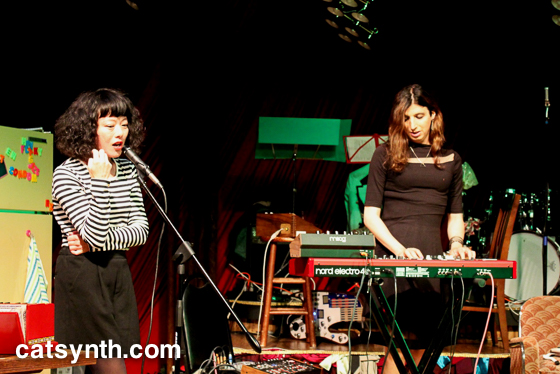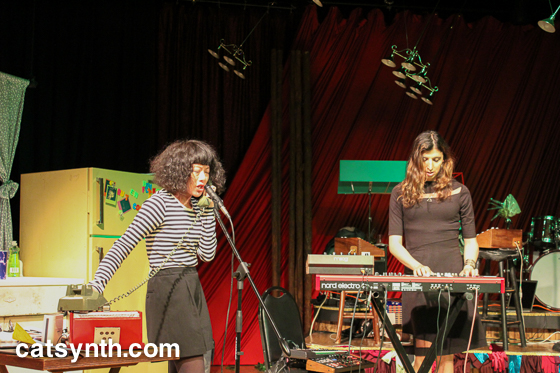Last week we reported on the the first night of NextNow Presents All Tomorrow’s After Parties that featured a performance by Vacuum Tree Head. Today we look at the next night of that festival, which took place on June 4 in Berkeley.

That event marked the debut of one of my new bands, Census Designated Place (or CDP). For this set, I was joined by Mark Pino on drums and Rent Romus on alto sax. The concept for this group is to combine my increased focus on jazz and funk with experimental sounds and ideas. We did two compositions of mine, plus an improvisation based on a graphical score painted by Mark. You can see and hear our full performance in this video.
CDP at Berkeley Arts, June 2016 from CatSynth on Vimeo.
Overall I was quite pleased with the set, and we all had a lot of fun. There is still some work to do tightening up the tunes (particularly White Wine), but that will come with time and practice. We were at our best with the rhythmic and idiomatic improvisation sections in all three pieces, especially the straight-eighth jazz and “disco” sections. And Rent did a tremendous job sitting in with the group, bringing a unique sound and style that I hope to continue in future performances.
All three of us also participated in the Lingua Incognita Session a project conceived by Mika Pontecorvo that also debuted at this event. The large ensemble featured two bassists (Eli Pontecorvo and Robert Kehlmann ), two drummers (Mark Pino and Aaron Levin, four wind players (Rent Romus, Kersti Abrams, Jaroba and Joshua Marshal, trumpet (Tony Passarell), keyboard (myself), and experimental electronics (Jack Hertz).









This was quite a cast of characters to put together in a single group, let alone a purely improvisational group that had not rehearsed together before. And it could have pure cacophony, but everyone did their part to make this work. We started with a concept based on A Love Supreme, with different performers moving in and out of the texture, which moved between sections of rhythmic jamming and more abstract tones. I know I had a lot of fun, as did others, and we hope to do this again sometime.
The day began quite a bit earlier with Shiva X, which featured Tony Passarell on tenor saxophone and Robert Kehlmann – both of whom were part of the Lingua Incognito set – along with Jim Frink on drums.

This group has some conceptual similarities with CDP, combining noisy elements with steady rhythmic drums and bass, but with a more freeform upper layer provided by Passarell’s saxophone. My favorite moments were when things converged on a groove.
Shiva X was followed by Trois Chapeaux. The group featured Jaroba, Kevin Corcoran and Jorge Bachmann (with regular member Tania Chen absent on this occasion).

This was a much more abstract sound, combining both small electronics and acoustic elements along with Bachmann on modular synth. Recognizable sounds and fragments came in and out of focus throughout the set, while clouds of noise and complexity coalesced and then dissipated.
Jack Hertz was next with a solo electronic performance. Sitting alone and unassuming at the from the room, he brought forth a variety of sounds from synthesizers, recordings, and other sources into a continuous force of music and noise. There were some soft but still delightfully crunchy moments in there as well.

The following set shifted from electronic to acoustic, but in such a way that many of the same sonic elements were preserved. There is probably few acoustic duos that sound as “electronic” as T.D. Skatchit, featuring Tom Nunn and David Michalak on sketch boxes.

The sounds of the sketch box are quite unique, and particularly tuned with the musicians who play it the moment. But there is still a tremendous variety.
Then it was time for Reconnaissance Fly, featuring the new lineup that now includes Brett Carson on keyboards along with Polly Moller (flute, guitar, voice), Tim Walters (bass), Rich Lesnick (winds) and Larry-the-O (drums).

The played a variety familiar tunes from the band’s catalog, including a couple from the first album, the recent regular rotation, and a couple of brand new songs. The overall sound of the group has coalesced into something that has strong jazz elements also quite whimsical and esoteric.
After CDP was v’Maa, a “drone band based upon Sami shamanism and spider mythology” (as described on Mark Pino’s blog). The group featured video and music with Mika Pontecorvo, Eli Pontecorvo, Kersti Abrams and Mark Pino. They were joined on this occasion by Lau Nau on voice.

After the intensity of many of the previous sets (including CDP), there was a more subdued quality, a bit more floating and meditative. The swells and ebbs in the overall texture worked will with the changes in the video; and it was a great way to relax musically after performing.
Next up was the “Bill Wolter Project”, featuring Bill Wolter on guitar, Moe! Staiano on percussion, Ivor Holloway on horns, and Ron Gruesbeck on synth.

The entire set, which was shrouded in mystery ahead of the evening, focused on made-up tunings anchored by Bill on fretless guitar. The music unfolded truly as an experiment, as the performers moved in out of various sounds within the confines of the new tuning.
The Bill Wolter Project was followed by Earspray, featuring Ann O’Rourke, Carlos Jennings and Mark Pino, who is definitely the hardest working man in the new music scene.

The set was a full explosion of noise, lights and video, made more stark by the performers’ lab coats. The sounds were a mixture of samples, synthesis and drums.
The final set of the evening was Tri-Cornered Tent Show. The current line-up for band features Philip Everett, Ray Shaeffer, Anthony Flores and Valentina O.

As with previous times I have heard the group, there was a foundation of explosive electronics and drum phases and free improvisation that moved between disparate rhythms and melodic lines. And there is a theatricality to the performance. But this performance with Valentina O was more cabaret style with humor and a certain intimacy. Between vocals, drum hits, and electronic sounds from Everett there were bits of quiet and silence perfectly timed for the theater of of the set.
This was an exhausting day of music, both as a performer and an audience member, but a rewarding one. I’m glad we stayed around for the entire day to hear everyone and the wide variety of sounds and styles. Thanks again to Mika Pontecorvo and Eli Pontecovro for putting on this evening, bring together so many musicians for a good cause.
















































